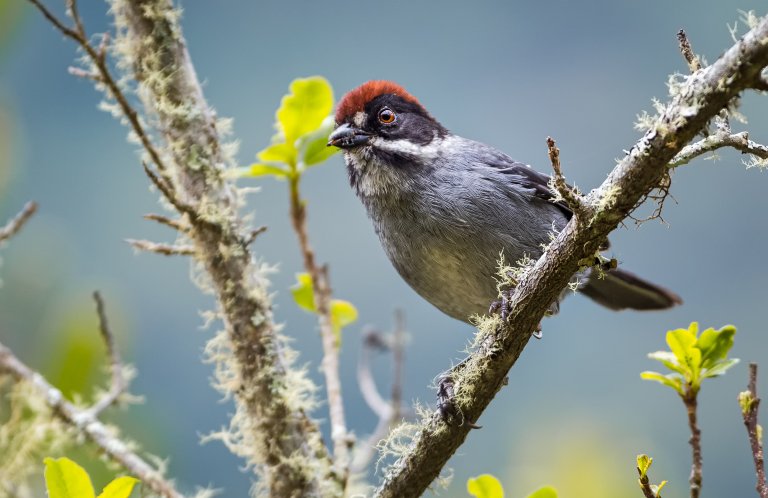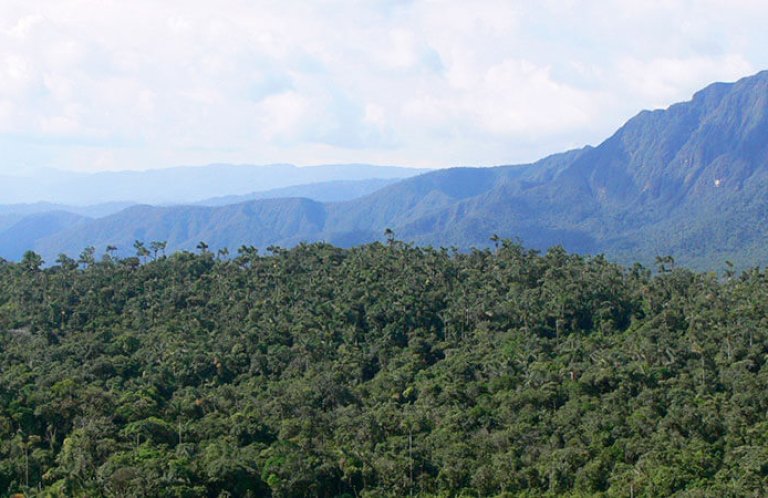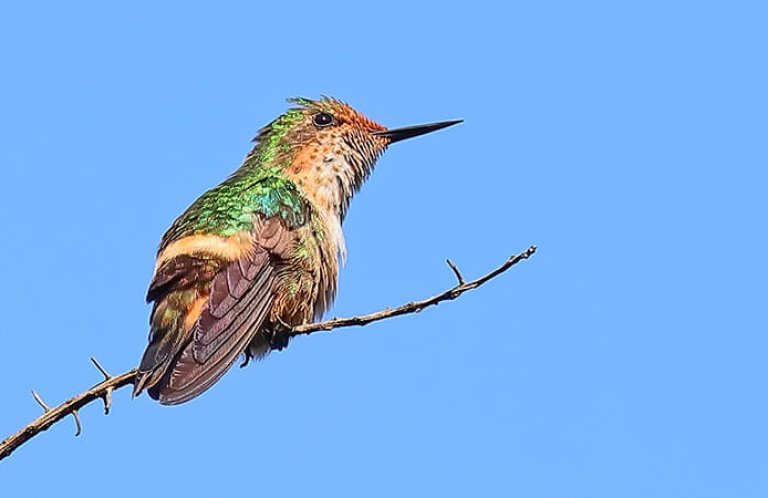A Question of Habitat: Saving Rare Birds Large and Small
The Pale-headed Brushfinch was rediscovered in a dry inter-Andean valley in west-central Ecuador almost 25 years ago — following three decades without a record of the species. A wave of relief rolled over those on the expedition that found this “lost” bird, an effort spearheaded by Fundación de Conservación Jocotoco (Jocotoco) with ABC support. But relief soon turned to worry.
After all, it seemed at the time that the species numbered about 15 pairs. Worse yet, as far as anyone knew, the Pale-headed Brushfinch only occurred on about 60 acres — an area the size of one or two U.S. high school campuses — within the Río Yunguilla Valley.

Jocotoco and ABC immediately began conservation efforts by acquiring, protecting, then improving habitat for the brushfinch, while taking actions to prevent wildfire and other threats to the land. Over the past few decades, the Pale-headed Brushfinch's story has become a shining example of how, even in a small area, a species can be saved from extinction, following clear-headed strategy based on sound research. In 2021, the total population was estimated to have tripled to about 240 individuals, with 112 known territories. All told, Jocotoco and ABC, along with Rainforest Trust, have protected about 485 acres of brushfinch habitat. As a result of these actions, the species was downlisted on the International Union for Conservation of Nature's (IUCN's) Red List from “Critically Endangered” to “Endangered.”
It seems as though, for the Pale-headed Brushfinch, an area of 485 acres has been sufficient to prevent its extinction. And for many other highly localized species, a relatively small amount of habitat also can go a long way toward saving them. But formulating the right recipe for the long-term conservation of a rare bird species is a varied and vexing challenge, made all the more urgent when that bird sits squarely in extinction's crosshairs. Of course, this is partly because every species has unique habitat needs. Consider, for example, that Yellow Warblers and House Wrens have been known to nest on territories smaller than an acre, while eagles may require thousands of acres for a pair to establish a successful nest.
A well-executed plan is only as good as its intel. Before conservationists jump into action to save a species, they at least need likely estimates of a species' population size, location, and current threats. They will have to gather lots of information on topics from the habitat needs mentioned above, to identifying critical characteristics of the habitat, to understanding how the habitat fits in the landscape, to how rapidly the habitat is being lost. To quickly address many of these topics, they often use some rules of thumb to make educated guesses.

Unlike familiar birds that have been studied for decades or even centuries, such as the Blue Tit in Europe, Yellow Warbler in North America, or gamebirds like doves or turkeys, rare birds sometimes land in our laps without much information with which to start our work. That's where we are right now with the Pale-headed Brushfinch's cousin, the Antioquia Brushfinch. There were no records at all for this species from 1971 until its rediscovery near Medellín, Colombia, in 2018; before then, it was only known from specimens in museum drawers, with no notes or illustrations of the species' behavior in the wild. This songbird is now considered Critically Endangered and in dire need of conservation. Its main threat: habitat loss. The area where this songbird was rediscovered has largely been converted to agriculture including crops, pastures, and dairies — land uses that are inhospitable to the persistence of many local plants and animals, let alone an imperiled bird. But field research has revealed that Antioquia Brushfinches do survive in shrubby natural habitats adjacent to some of these areas.
The “500” Rule of Thumb

Now that the general area is known, the conservation challenge is to determine all places where the Antioquia Brushfinch may occur. Led by partner Corporación SalvaMontes, searches of the surrounding area and likely sites are ongoing, with conservationists and birders from around the region seeking the bird in auspicious-looking habitat patches.
This work to define a range for the species and its preferred habitat is the first step. But the question remains, how much habitat is enough? Obviously, it must be enough to provide a place for an adequate population of the species to thrive. Now, what's an “adequate population?” One rule of thumb that conservationists have long used is a minimum population size of 500 individuals. This number is thought, in general, to provide for enough genetic diversity that inbreeding can be avoided, and it provides a bit of a buffer to allow the population to survive a loss in bad years — say, due to fires, storms, or food scarcity brought on by drought. A higher number would of course be better, but protecting habitat for 500 makes a good start.
The preferred habitat of many highly localized rare birds often doesn't exist in large blocks. Fortunately, these days, mapping using powerful tools like satellite imagery and geographic information system (GIS) software is a key part of the conservationist toolkit, helping to identify the occupied and potentially occupied habitat parcels.
SIDEBAR: How Much Is Enough? An Antpitta's Tale
For many species, a relatively small amount of protected habitat can go a long way to protecting against extinction. Consider the highly localized and Endangered Cundinamarca Antpitta. This long-legged, stubby-tailed forest bird was described as a species in 1992 and is only found within a small sliver of the Andes southeast of Bogotá, Colombia.
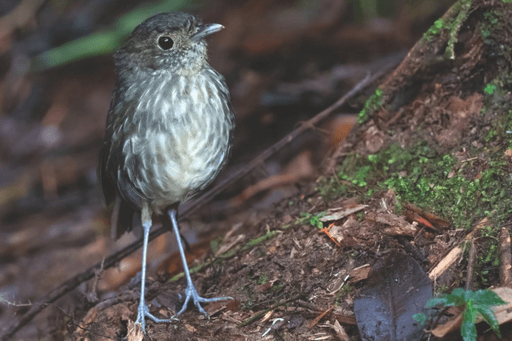
To evaluate whether the Cundinamarca Antpitta has enough protected habitat for survival, we looked at how much habitat would be needed to support 500 individuals — a minimum population size. To evaluate this, we worked with two facts:
•About 178 square kilometers (sq. km) of the species' habitat was currently protected, based on our gap analysis (see "Saving the Rarest, Small and Great," below).
•Two to three Cundinamarca Antpittas were thought to occur in each sq. km, based on BirdLife International data.
Using the lower population estimate of two birds per sq. km, we were able to estimate that only 356 birds can be supported by existing protected habitat.* To get to our target of 500 individuals, we would need to protect enough habitat to support 144 more birds. Again, using the two-birds-per-km guideline, we were able to estimate that another 72 square km of protected habitat would be needed to support a population of 500.**
To sum it up: To adequately protect the Cundinamarca Antpitta, we'd need to add an additional 72 sq. km to the existing 178 sq km protected, for a total of about 250 sq km.*** That's an area smaller than Theodore Roosevelt National Park in North Dakota.
Even though the Cundinamarca Antpitta is the focal species in this case, many other birds share its habitat and thus benefit from its conservation. These species include residents like the Lined Quail-Dove, Tawny-breasted Tinamou, Black-collared and Green Jays, and the Vulnerable and endemic Brown-breasted Parakeet. Winter visitors that benefit from protection of the antpitta's habitat include the Blackburnian Warbler and Broad-winged Hawk. —Daniel J. Lebbin
* 178 sq. km x 2 birds/sq. km = 356 birds supported
** 72 sq. km x 2 birds/sq. km = 144 birds supported
*** 178 sq. km + 72 sq km = 250 sq. km needed to support 500 birds
Saving the Rarest, Small and Great
At ABC, one important goal of our work is to protect all of the species of threatened birds in the Americas, Hawai‘i, and U.S. Pacific territories. Unfortunately, there are a lot of threatened bird species. For the most threatened species alone — those classified by the IUCN as Critically Endangered and Endangered — that currently means 263 bird species, 189 of which are primarily threatened by habitat loss. To make our efforts more efficient, ABC has been working on a project we've given the name “gap analysis,” to identify the gaps in protection for most of the habitat-limited threatened species. Our first step, working with partners in Stuart Pimm's lab at Duke University, has been to develop accurate distribution maps for many of these “gap” species — at least those with populations large enough that it's possible to make a map. (It's hard to map the “lost” birds, those that haven't been seen for many years!)
A key finding of overlaying the ranges and habitat of many threatened species is that, in some areas, many species needing habitat protection occur together. This is what we're looking for: opportunities to protect many species at once. This makes conservation more efficient, but it also helps to keep ecosystems intact, aiding the conservation of many species beyond birds. After all, an ecosystem is not just made up of birds, although they can serve as good indicators of high-quality habitat. Where there are many birds, there are likely to be many other organisms as well.
The goal of protecting multiple rare bird species at a time adds a new layer to our question of what is the right recipe needed for conservation. This goal requires getting the 30,000-foot view, being able to see where all of the birds' ranges fit together, to be able to focus on that area for conservation. By overlapping our conservation efforts, we can protect enough habitat and do it for many species.
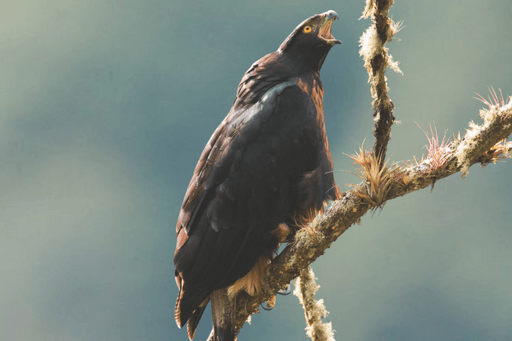
Some birds, however, are very dispersed across the landscape and therefore require very large areas of protected habitat to support a reasonable population size and ensure the species avoids extinction. For species in this category, such as the Endangered Black-and-chestnut Eagle or the Critically Endangered Blue-billed Curassow, protecting only small areas of perhaps a few hundred or even a few thousand acres will not be enough.
For such species, larger-scale action is needed to protect and connect lands. One such effort is the 30×30 initiative, drafted by the United Nations Convention on Biological Diversity, which aims to protect 30 percent of Earth for conservation by 2030. The current Administration has a similar goal for the U.S. Not all the conservation land under the 30×30 initiatives will be locked into parks and preserves. Much would still be used in agriculture, but in a sustainable way. Even small changes in intensive agriculture — like leaving fencerows with native vegetation — can help to save habitat for birds and contribute to conserving enough land even for wide-ranging species like eagles and curassows.
Migratory birds require still other considerations. They occupy at least three different habitats throughout their life-cycles: breeding grounds, wintering grounds, and migratory stopovers. The magnificent Whooping Crane has been brought back from the edge of extinction by conservation of places where the species breeds in Canada, as well as on wintering grounds on the coast of Texas, and at stopover sites such as along the Platte River in Nebraska. These same complications also arise for small migratory birds like the Golden-cheeked Warbler, a species that nests only in Central Texas and winters in scattered mountainous regions in southern Mexico and Central America.
No Cookie-Cutter Case

We look at each species as a separate, special mission. In some cases, we're trying to reach “enough” habitat through acquisition and protection of key parcels, as is now starting to be done for the Antioquia Brushfinch. In other cases, large-scale efforts like the 30×30 initiative are necessary to provide habitat at a sufficient scale.
Often, combined efforts yield great results: Consider the example of one of the world's smallest owls. The Long-whiskered Owlet, a bird of high, remote, wet, and very steep cloud forests, remained unknown to science until 1976. After its discovery, the owlet wasn't consistently seen for another 31 years, until 2007, when it was found in northern Peru at an area called Abra Patricia.
With support from ABC, our partner Asociación Ecosistemas Andinos (ECOAN) now owns and manages a reserve there, protecting more than 25,000 acres for the owl and an ark of other species, including the Endangered Ochre-fronted Antpitta, the Critically Endangered Peruvian Yellow-tailed Woolly Monkey, the Spectacled Bear, and many rare and endemic plants. This area protects a key part of the owlet's range, plus there are adjacent government-owned and other conservation lands adding further protection. Together, these areas are likely to sustain this bird's population long term. In 2020, the IUCN downlisted the owlet from Endangered to the no-longer-highly-threatened status of Vulnerable.
The “right recipe” seems to have been found for more and more rare bird species. The Pale-headed Brushfinch mentioned above seems to be one that can be put in the success category. The Lear's Macaw was a species thought 40 years ago to number fewer than 100 birds, but now there are more than 1,600, and the species has been downlisted from Critically Endangered to Endangered by the IUCN. The macaw's success has largely resulted from increased protection of its habitat with the establishment of a reserve by ABC's partner Fundação Biodiversitas. (This species is now being threatened by development of a wind power project in its foraging areas, which can put large, high-flying birds in danger.)
Habitat is the key for so many species, and it is always a challenge to know how much is enough. But thanks to collaboration, modern science, and a broad range of ways to conserve land, we continue to craft conservation recipes that help to save the rarest of the rare.
SIDEBAR:Many Rare Species, One BirdScape
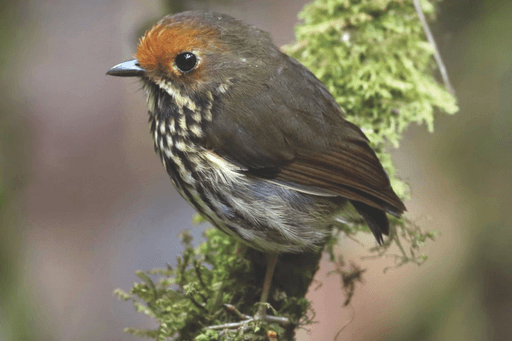
Modern tools like GIS mapping and record databases help conservationists draw up game plans for assuring the long-term conservation of multiple rare species in the same areas. For example, in Peru's Colan-Alto Mayo BirdScape — one of nearly 100 ABC priority areas for landscape-scale conservation — mapping reveals habitats where the range-restricted Long-whiskered Owlet and Ochre-fronted Antpitta can both be found. Protecting these lands in reserves, such as the ABC-supported Abra Patricia Reserve, helps to ensure habitat for these and many other birds (including the Endangered Lulu's Tody-Flycatcher and the Royal Sunangel), as well as scarce, wide-ranging mammals like the Critically Endangered Peruvian Yellow-tailed Woolly Monkey and the Spectacled Bear — the continent's only bear, which is listed as Vulnerable. ABC's partner in Peru, Asociación Ecosistemas Andinos (ECOAN), manages Abra Patricia Reserve, while communities and the government protect other large areas of habitat.
 David Wiedenfeld is ABC's Senior Conservation Scientist. He received his Ph.D. from Florida State University. His work has focused on bird population ecology and conservation biology. David served for five years as Director of Research at the Sutton Avian Research Center, working primarily on prairie-chickens. He was also Head of the Department of Vertebrate Ecology at the Charles Darwin Research Station in the Galapagos Islands.
David Wiedenfeld is ABC's Senior Conservation Scientist. He received his Ph.D. from Florida State University. His work has focused on bird population ecology and conservation biology. David served for five years as Director of Research at the Sutton Avian Research Center, working primarily on prairie-chickens. He was also Head of the Department of Vertebrate Ecology at the Charles Darwin Research Station in the Galapagos Islands.






































